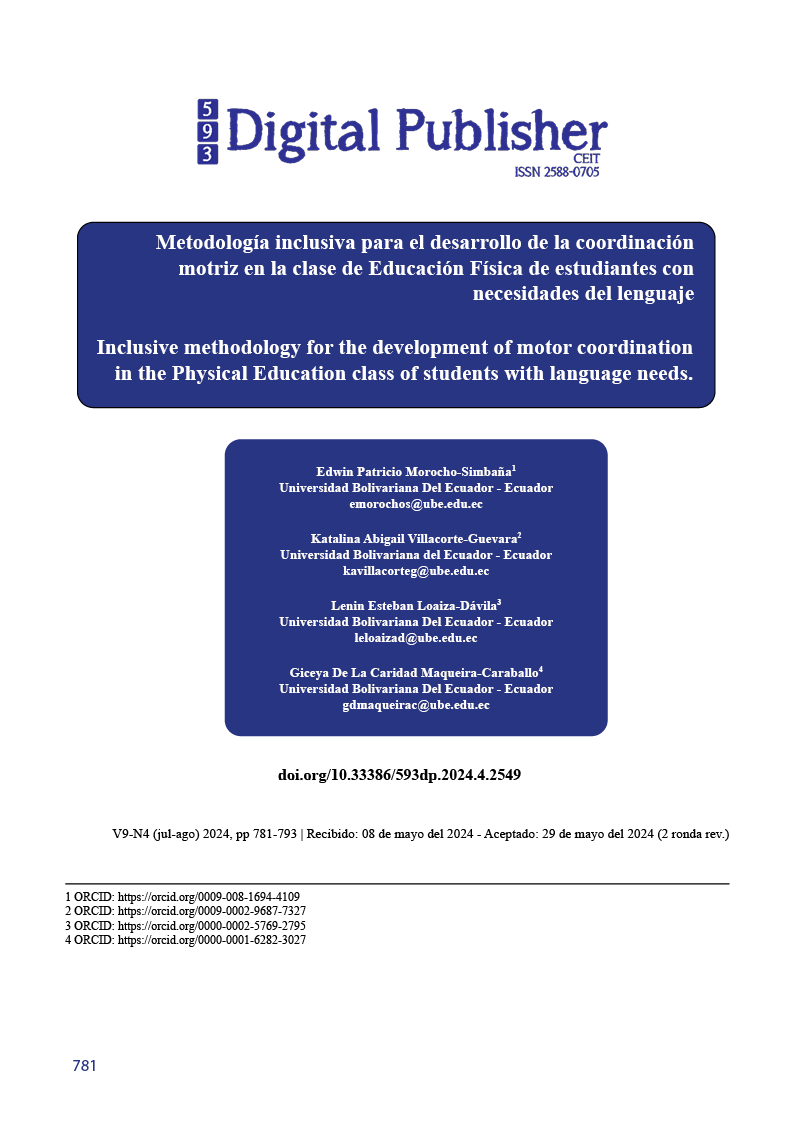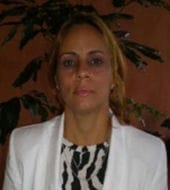Inclusive methodology for the development of motor coordination in the Physical Education class of students with language needs
Main Article Content
Abstract
The main objective of this study was to design and evaluate the effectiveness of an inclusive methodology specifically adapted for the development of motor coordination in students with language needs, such as dyslexia and dysgraphia, within the context of Physical Education classes. A mixed sample of 31 students was selected, 28 (90.3%) without language needs and 3 (9.7%) with them. The research was based on a quantitative approach, with a pre-experimental research design. The observation technique was applied and the 3JS test and a quantitative observation form were used as instruments for the evaluation of inclusive processes in the Physical Education class. The statistical analysis of the results was carried out through the SPSS statistical package version 26 IBM applying the Wilcoxon nonparametric test for related samples. The intervention proposal was based on an inclusive methodology for the development of motor coordination in the Physical Education class of students with language needs, implemented over 8 weeks with 2 classes per week. The analysis of the results showed that the inclusion evaluated in the Physical Education class improved in all dimensions, i.e. the inclusive methodology proposal is effective in improving the dimensions of inclusion and thus improving the development of motor coordination, with special emphasis on those students who have some kind of language needs such as dyslexia.
Downloads
Article Details

This work is licensed under a Creative Commons Attribution-NonCommercial-ShareAlike 4.0 International License.
1. Derechos de autor
Las obras que se publican en 593 Digital Publisher CEIT están sujetas a los siguientes términos:
1.1. 593 Digital Publisher CEIT, conserva los derechos patrimoniales (copyright) de las obras publicadas, favorece y permite la reutilización de las mismas bajo la licencia Licencia Creative Commons 4.0 de Reconocimiento-NoComercial-CompartirIgual 4.0, por lo cual se pueden copiar, usar, difundir, transmitir y exponer públicamente, siempre que:
1.1.a. Se cite la autoría y fuente original de su publicación (revista, editorial, URL).
1.1.b. No se usen para fines comerciales u onerosos.
1.1.c. Se mencione la existencia y especificaciones de esta licencia de uso.
References
Baharudin, N., Harun, D., Kadar, M., Rasdi, H. e Ibrahim, S. (2019). Rendimiento de las habilidades motoras gruesas en niños con dislexia: una comparación entre niños más pequeños y mayores. Jurnal Sains Kesihatan Malasia. https://doi.org/10.17576/JSKM- 2019-1702-14
Garbenis, S., & Geležinienė, R. (2023). Desarrollo de rasgos de adaptación en estudiantes con necesidades educativas severas durante la Educación Física de la escuela primaria. Revista De La Universidad Del Zulia, 14(41), 456-472. https://doi.org/10.46925//rdluz.41.24
González-Bustos, J. B., Cervantes-Hernández, N., Domínguez-Esparza, S., & Enríquez-Del Castillo, L. A. (2021). Intervención psicomotriz en un alumno con disgrafía: estudio de caso. Revista Iberoamericana de Ciencias de la Actividad Física y el Deporte, 10(1), 49-58.
Guerrero, M., & Puerta, L. (2023). Advancing Gender Equality in Schools through Inclusive Physical Education and Teaching Training: A Systematic Review. Societies. https://doi.org/10.3390/soc13030064
Kristén, L., Klingvall, B., & Ring, M. (2022). The co-development of inclusive tools in physical education for pupils with and without disabilities. Sport in Society, 25(5), 1000–1016. https://doi.org/10.1080/17430437.2020.1819243
Lakkala, S., Galkienė, A., Navaitienė, J., Cierpiałowska, T., Tomecek, S., & Uusiautti, S. (2021). Teachers Supporting Students in Collaborative Ways—An Analysis of Collaborative Work Creating Supportive Learning Environments for Every Student in a School: Cases from Austria, Finland, Lithuania, and Poland. Sustainability, 13, 2804. https://doi.org/10.3390/SU13052804.
Lei, M., Qu, M., Zhu, J. y Wang, Y. (2022). Inclusión educativa efectiva para estudiantes con TEA. Actas de la Tercera Conferencia Internacional sobre Salud Mental, Educación y Desarrollo Humano de 2022 (MHEHD 2022). https://doi.org/10.2991/assehr.k.220704.023
Lichahi, R., Azarian, A. y Akbari, B. (2019). La eficacia de la terapia de juego sobre el rendimiento lector, las habilidades adaptativas y los problemas de conducta en estudiantes con dislexia. Revista trimestral de salud mental infantil. https://doi.org/10.29252/jcmh.6.3.18
Meškauskienė, A. (2017). El impacto del entorno docente en la formación de la autoestima de los adolescentes. Revista Europea de Educación e Investigación en Ciencias Sociales, 10, 112-120. https://doi.org/10.26417/EJSER.V10I1.P112-120
Morley, D., Bailey, R., Tan, J. y Cooke, B. (2005). Educación Física Inclusiva: visión del profesorado sobre la inclusión de alumnos con Necesidades Educativas Especiales y/o discapacidad en Educación Física. Revista europea de educación física, 11, 107 - 84. https://doi.org/10.1177/1356336X05049826.
Muñoz, Y. V., & García, D. Y. (2020). La disgrafía motriz en el aula de clases. Expresiones, (10), 29-35.
O’Neil, K., & Olson, L. (2021). Promoting Social Acceptance and Inclusion in Physical Education. TEACHING Exceptional Children, 54, 6 - 15. https://doi.org/10.1177/00400599211029670.
Pavlovic, M., Simonton, K., & Casey, L. (2022). Inclusive Practices in Physical Education: Considerations for Students With Dyslexia. Journal of Physical Education, Recreation & Dance, 93, 15 - 21. https://doi.org/10.1080/07303084.2022.2081271
Peters, J., Losa, L., Bavin, E., & Crewther, S. (2019). Efficacy of dynamic visuo-attentional interventions for reading in dyslexic and neurotypical children: A systematic review. Neuroscience & Biobehavioral Reviews, 100, 58-76. https://doi.org/10.1016/j.neubiorev.2019.02.015.
Pocock, T. y Miyahara, M. (2018). Inclusión de estudiantes con discapacidad en educación física: un metanálisis cualitativo. Revista Internacional de Educación Inclusiva, 22, 751 - 766. https://doi.org/10.1080/13603116.2017.1412508
Prince, E. y Hadwin, J. (2013). El papel del sentido de pertenencia escolar en la comprensión de la eficacia de la inclusión de niños con necesidades educativas especiales. Revista Internacional de Educación Inclusiva, 17, 238 - 262. https://doi.org/10.1080/13603116.2012.676081
Purpura, D., & Schmitt, S. (2019). Cross-domain development of early academic and cognitive skills. Early Childhood Research Quarterly. https://doi.org/10.1016/J.ECRESQ.2018.10.009
Roitsch, J., & Watson, S. (2019). An Overview of Dyslexia: Definition, Characteristics, Assessment, Identification, and Intervention. Science Journal of Education. https://doi.org/10.11648/J.SJEDU.20190704.11.
Roldán, S., Marauri, J., Aubert, A. y Flecha, R. (2021). Cómo los entornos de aprendizaje interactivos e inclusivos benefician a los estudiantes sin necesidades especiales. Fronteras en Psicología , 12. https://doi.org/10.3389/fpsyg.2021.661427
Salend, S. (2000). Estrategias y recursos para evaluar el impacto de los programas de inclusión en los estudiantes. Intervención en Escuela y Clínica , 35, 264 - 289. https://doi.org/10.1177/105345120003500502
Taff, S., & Clifton, M. (2022). Inclusion and Belonging in Higher Education: A Scoping Study of Contexts, Barriers, and Facilitators. Higher Education Studies. https://doi.org/10.5539/hes.v12n3p122.
Tarjiah, I., Supena, A., Pujiastuti, S. y Mulyawati, Y. (2023). Incrementar la capacidad lectora de un estudiante con dislexia en la escuela primaria: un estudio de caso explicativo mediante el uso de apoyo familiar, enseñanza de recuperación y método multisensorial. Fronteras en Educación. https://doi.org/10.3389/feduc.2023.1022580
Uchôa Bulhões Campos, J.d.S., Signoretti, A., Almeida, A.M.P. (2020). Creating New Learning Experiences for Students with Dyslexia: A Design Thinking and Human-Centered Approach. In: Rehm, M., Saldien, J., Manca, S. (eds) Project and Design Literacy as Cornerstones of Smart Education. Smart Innovation, Systems and Technologies, vol 158. Springer, Singapore. https://doi.org/10.1007/978-981-13-9652-6_23
Van de Walle de Ghelcke, A., Skoura, X., Edwards, M. G., Quercia, P., & Papaxanthis, C. (2021). Action representation deficits in adolescents with developmental dyslexia. Journal of neuropsychology, 15(2), 215–234. https://doi.org/10.1111/jnp.12220
Widianti, A., Aryanata, N. y Pramitya, A. (2018). La exploración de la empatía del profesor de escuela primaria inclusiva en Denpasar. https://doi.org/10.2991/ICCITE-18.2018.7 .
Zhong, Y. (2002). Protección jurídica del derecho a la dignidad de los estudiantes. Teoría y práctica de la educación.





